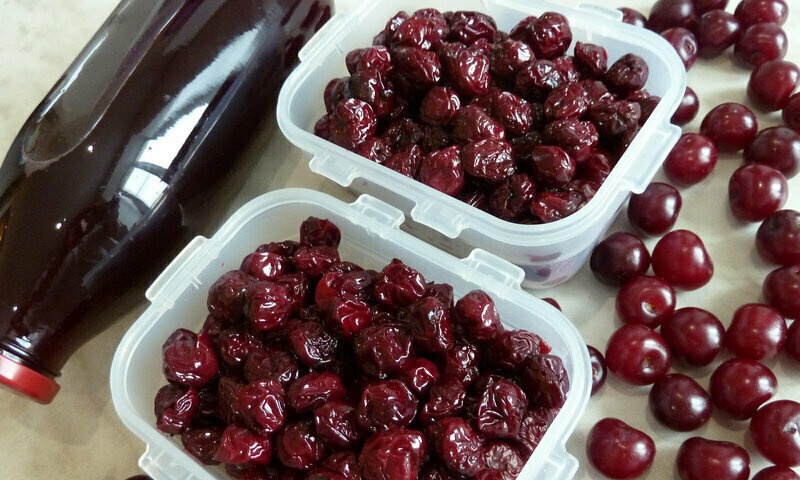Admin. Sorry off topic ...
On foreign sites they write about 166% leaven. How to calculate these percentages. by what formula (if I may say so). can you tell me .....
I answer the question, but the material is great and is it worth giving. See if it helps you. However, perhaps this material will interest someone else.
How to calculate how much starter is needed in a recipe instead of yeast? (based on materials from i-net)
There are 2 types of leaven used in the Bible of Bread: liquid (the one we use) and dense.
Before transferring the quantity of yeast to the quantity of starter culture, the author recommends re-weighing the liquid into dense first.
Liquid to dense conversion: if the recipe requires a dense leaven (it is like a dough in consistency) and you have a liquid one, then you can fix it in 2 ways:
1. by weight: if you need 150 g of dense starter culture and you have a liquid one, you need to increase the amount of the required starter culture by one third (we get 200 g) and then take away the excess amount of liquid in the starter culture (a quarter of the total weight of the liquid starter culture, i.e. 50g), reducing the water in the recipe.
2. by volume: just knead flour into the leaven, 1 teaspoon at a time, until the consistency of the leaven becomes so dense that it does not stick to your hands. Knead well, adding a little more flour.
Transfer of yeast quantity into starter culture:A dense leaven is used.
To obtain the amount of required dense starter culture you need:
1. Add the weight of flour and water in the recipe
2. Multiply the total of item 1 by 30% to get the amount of the required starter culture
3. Since the sourdough also contains flour and water (1/3 water and 2/3 flour) divide the resulting quantity of sourdough by 3 to get the amount of water it contains and by 1.5 to get a count - two flour.
4. Subtract the resulting numbers from the number of these ingredients required by the recipe.
For example, in a recipe we have:
Flour: 100 gr
Water: 68 gr
Salt: 3.7 g
Yeast: 0.5 gr
1.100 + 68 = 168gr
2.18gr x 30% = 50.4gr (rounded up to 50) is the weight of our starter culture used in this recipe
3.50gr: 3 = 16.6gr (water); 50gr: 1.5 = 33.3gr (flour)
4. 100gr - 33.3gr = 66.7gr (weight of the flour used from the recipe when using sourdough instead of yeast); 68g - 16.6g = 51.4g (weight of water used from the recipe when using sourdough instead of yeast)
The amount of salt remains unchanged, yeast is not used.
Leavened culture 1. We need to grow a leavened culture. To do this, we need warm water (no warmer than 40c), flour (depending on what crop you want, wheat, rye, spelled), a bowl-jar ~ 4l, a warm place (battery, put a plate under the dish), spoon ( better wooden). The flour should be of the type 1050,1150, which means that ordinary "kitchen" flour is not suitable (we need bacteria and yeast, which are present on the shell of the grains, and low types of flour are already devoid of them). For feeding-activation, you can take any kind of flour. Mix thoroughly every 12 hours. The consistency of the pancake dough.
1-4 (5) days: stir in (add to our mixture) every day ~ 100g of flour and 100ml of water.
The process that is observed at this time depends on many parameters, therefore it proceeds very differently: from vigorous fermentation to complete calmness. The main indicators that everything is going according to plan are color (not red, blue, green, black) and smell (sour, smell of flour). If our porridge stinks, grows moldy, has the listed wrong shades, then bacteria that we do not need have got in (keep it clean at all stages) and must be thrown out.
Our mixture is a ready-to-eat sourdough culture if it starts to grow actively and after that it has fallen off (can be seen on the trace-border on the dishes). After ~ 6 hours, she is ready for the next step.
2. From the mass we received, we take 400-500g for our first bread (we will leave the rest).
Add the yeast one last time (our starter is still young and weak).
500g sourdough
500g wheat 1050 or rye 1150 flour
1 tbsp. l. salt
1/4 cube of yeast ~ 10g or 1/2 bag of dry yeast
200 ml warm water
If the wheat flour is kneaded well, form a loaf.
If the rye is simply mixed, the dough will be very sticky, it is better to use a mold to form the bread!
Leave to warm for an hour.
Preheat the oven to 220c, make ~ 2cm cuts and bake. At the bottom of the oven a bowl (heat-resistant) with water ~ half a glass. After 15 minutes, reduce to 180 s and bake for another 50-60 minutes. Allow to cool on a wire rack under a towel. Cut the next day!
Put the remaining sourdough in a well-washed and once again cold water in a rinsed jam jar in the refrigerator. We will feed our starter as needed: prepare it for use.
3. Now we have a leaven, which we must each time to bring to a state of readiness (activate) before direct consumption. It should be remembered that 40s-max is the permissible temperature for our test.
There are 3 ways to activate:-classical 3-stage, the most laborious, but also the most optimal;
-1-step Detmold, simple, but does not give the optimal result of yeast-free baking;
-modified 3-stage.
All examples are designed for 600 g of ready-made sour dough, if you need a different amount, you must calculate accordingly.
-classical 3-stage:
18-24 hours, different temperatures, different dough consistency.
Stage 1 (acid refreshing) mainly yeast multiplies (this means microorganisms, not pressed yeast!):
100g flour + 100ml warm water + 50-100g starter culture
4-6 hours at 22-26s.
Stage 2 (basic acid) acid is added:
+ 100g flour + 30-50 ml of warm water mix into a (more) dense dough
6 hours at almost 30 seconds (or up to 8 hours, but the dough is even denser from 22 seconds, a stronger development of acetic bacteria).
Stage 3 (full acid) balances acetic and lactic acids.
+ 100g flour + 150-180ml warm water very soft dough
3-4 hours at 28-30s.
1-stage Detmold
All ingredients are mixed in one step (300 g of flour + 300 ml of water + 50-100 g of grape culture). A constant dough temperature of 24-28 s is important. After 15-20 hours the full acid dough is ready to be used in the dough. This method was invented by Detmold (Grain Institute ...). Only suitable for stable crops, otherwise foreign bacteria may develop. In addition, the propagation of (own!) Yeast cultures is not optimal -> compressed yeast is added for good baking quality. Less sour dough, so at least 40% rye flour should be acidified.
modified 3-stageStage 1 (acid refreshing) mainly yeast multiplies (meaning microorganisms, not pressed yeast!):
100g flour + 100ml warm water + 50-100g starter culture
6-8 hours at 26-28s.
Stage 2 (basic acid) acid is added:
+ 100g flour + 100 ml warm water
6-8 hours at 22-26s.
Stage 3 (full acid) balances acetic and lactic acids.
+ 100g flour + 100ml warm water very soft dough
3-4 hours at 18-22s.
If the temperature is 2 degrees less than +1 hour (about 2 degrees + 1 hour). It is important to observe the decrease in temperature with each step.
Storage:we put part of the sour dough (culture) in a jam jar and put it in the refrigerator. The jar must be large enough as the dough may rise. Then the process will go into hibernation and the bank will be "calm". So it can be stored for 7-10 days. Over time, the dough will separate into thin and thick parts, this is normal.
You can also freeze, dry, crumble.
How much sour dough do we need?
There are 3 cases:
pure rye bread
30-50% of the flour must be acidified. The more, the more sour the bread will be.
Our sour dough consists of a 50:50 flour and water.
We need at least as much sour dough as rye flour we want to put in the dough in order to get non-sour bread.
We need no more than twice the sour dough than the rye flour that we want to put in the dough to get more sour bread.
Ie: for 500 g of rye flour, 500-1000 g of sour dough,
at the same time we reduce flour by 250-500gr and liquid by 250-500ml in the recipe.
mixed bread with rye flour
We acidify only rye flour! in the same way as above. At the same time, the amount of sour dough (flour in it) should not be less than 20% of the total, otherwise the sour dough yeast will not be enough for the bread to grow well.
wheat / splenta bread
30-40% wheat sourdough.
Ie: for 500g flour 150-200g sour dough,
at the same time we reduce flour by 70-100g and liquid by 70-100ml in the recipe.
Usually, sourdough means rye sourdough. But it also happens from other varieties of cereals.
rye sourdough
to suppress the enzyme phytin in rye flour, sour dough (milk and vinegar microorganisms in it) is necessary. Yeast organisms (sour dough) will give airiness to baked goods, but such dough rises worse than with wheat sourdough.
wheat leaven
the yeast and fermentation it contains are more important.
Less acidic. It will be even less acidic when you replace water with milk. Unfortunately, it is not so stable in relation to the development of foreign bacteria, since it contains less acid.
The easiest way is to "transform" our rye culture into a wheat one (and not breed two). To do this, for a 3-stage activation, simply take another flour (wheat, splenta). In this way we get the wheat leaven.
Basic rye bread recipe
500g starter culture (500ml)
500g rye flour
1 tbsp. l. salt
250 ml warm water
the dough will be very sticky, it is better to use a mold to form the bread!
Shape, cut ~ 2cm, sprinkle with water. Turn on the oven for 50 sec and put on the bread. After 20 minutes, leave only the light bulb on (30-40s). Leave to come up for 3-4 (even 5) hours. Spray with water occasionally. Remove the baking sheet with bread.
Preheat the oven to 250c and bake. At the bottom of the oven, a bowl (heat-resistant) with water ~ half a glass. After 10 minutes, reduce to 220s, after another 15 minutes, reduce to 190s and bake for another 40-50 minutes. Allow to cool on a wire rack under a towel for 3-4 hours, preferably overnight.
Bread maker:
1. fold everything up as usual.
2. turn on the "Dough" program.
3. Leave to come up further in the car (this way it keeps warm for several hours).
4. when it is sufficient to start the "Oven" program.
Bran bread (~ 1200gr)
For sour dough:
3 tbsp. l. leaven
200g whole grain rye flour
200ml warm water
Choux pastry:
100g rye bran
100g millet bran
100g barley bran
100gr of bran sponge
Boiling water to cover the bran.
100g whole wheat flour
100g whole grain rye flour
100g whole grain flour sponge
1 to 2 handfuls of large oatmeal
1 tbsp. l. salt
200ml water
In the evening, put all the ingredients for the sour dough in a bucket and leave overnight at room temperature. Boil the bran, cover and leave to swell.
The next day
Whole grain bread program (or Dough + proofer + Oven)
More information can be found in my section Bread - everything is head in the work of Professor Auerman. 







